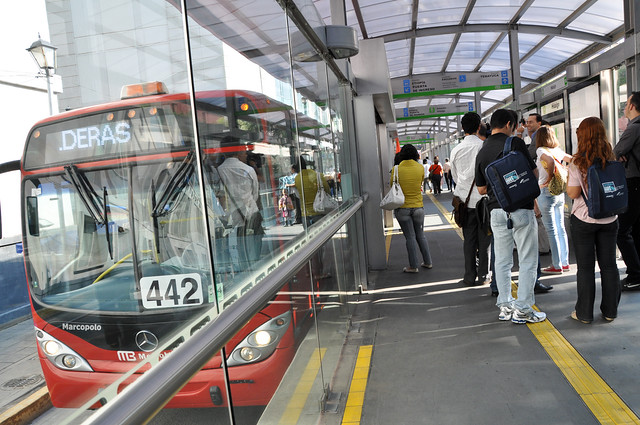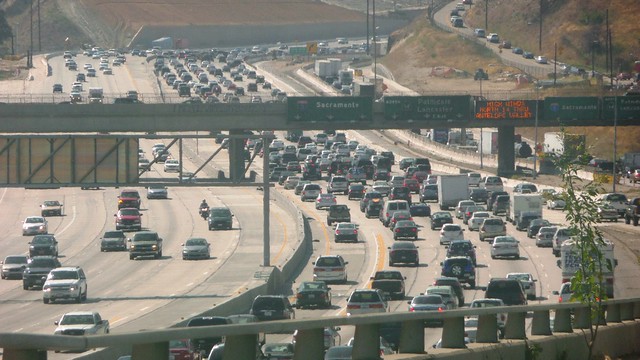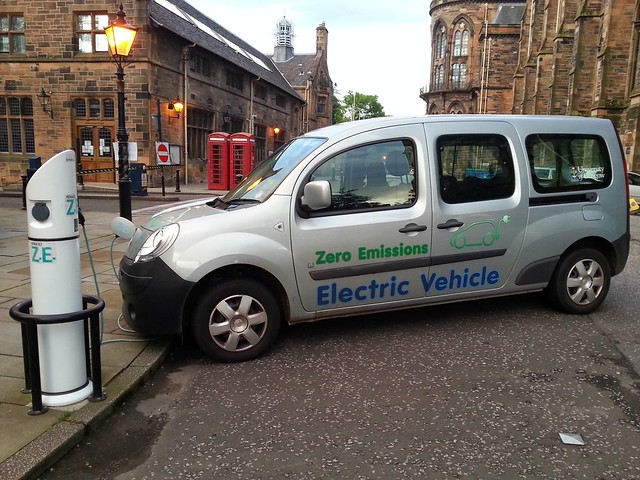New report shows how to reduce vehicle pollution, create financial savings on a global scale

Posted September 30, 2014 at 1:34PM
More than $100 trillion in public and private spending could be saved between now and 2050 if the world were to expand public transportation, walking and bicycling in cities, according to a new report released by the Institute for Transportation and Development Policy and the University of California, Davis. Additionally, reductions in carbon dioxide emissions reaching 1,700 megatons per year in 2050 could be achieved. Carbon dioxide is a potent greenhouse gas and a cause of global warming.
Further, an estimated 1.4 million early deaths associated with exposure to vehicle tailpipe emissions could be avoided annually by 2050 if governments were to require strong vehicle pollution controls and the use of ultralow-sulfur fuels, according to a related analysis by the International Council on Clean Transportation included in the report. Doubling motor vehicle fuel efficiency could also reduce global carbon dioxide emissions by an additional 700 megatons in 2050.
Carbon emissions in the US
In the United States alone, a major commitment to more sustainable transportation options could reduce carbon emissions due to urban passenger transportation from the country’s current, world-leading level of nearly 670 megatons annually to about 280 megatons annually by 2050. (According to the report, the US is already projected to lower current annual emissions to 560 megatons by 2050 because of slower population growth, higher fuel efficiencies, and a decline in driving per person that has already started as people move back to cities. But this pace could be sharply accelerated with a “High Shift” scenario described in the report.)
The report was co-authored by my friend Michael Replogle, ITDP’s managing director for policy, and Lew Fulton, co-director of the NextSTEPS Program at the Institute of Transportation Studies at UC-Davis. Here’s Replogle, commenting when the study was released earlier this month:
“Transportation, driven by rapid growth in car use, has been the fastest growing source of CO2 in the world. An affordable but largely overlooked way to cut that pollution is to give people clean options to use public transportation, walking and cycling, expanding mobility options especially for the poor and curbing air pollution from traffic.”
The report, A Global High Shift Scenario, documents the first study to examine how major changes in transport investments worldwide would affect urban passenger transport emissions and the mobility of different income groups.
The authors calculated CO2 emissions in 2050 under two scenarios, a business-as-usual approach and a “High Shift” scenario whereby governments would significantly increase rail and clean bus transport, especially Bus Rapid Transit (BRT), and help urban areas provide infrastructure to ensure safe walking, bicycling and other active forms of transportation. The projections also include moving investments away from road construction, parking garages and other measures that encourage car ownership.
Rapidly developing countries
The issues are particularly urgent because, in addition to high levels of vehicle-related pollution in the US, rapidly developing countries such as China and India are poised to put massive numbers of additional vehicles on the road in the coming decades. In China, CO2 emissions from transportation are expected to increase nearly six-fold from 190 megatons annually to more than 1,100 megatons, due in large part to the explosive growth of China’s urban areas, the growing wealth of Chinese consumers, and their dependence on automobiles. But the report says this increase can be slashed to 650 megatons under the High Shift scenario, in which cities would develop extensive BRT and metro systems. (The latest data show that China is already increasing investments in public transport. The recommendations would accelerate those investments.)
In India, CO2 emissions are projected to leap from about 70 megatons today to 540 megatons by 2050, also because of growing wealth and urban populations. This increase can be moderated to only 350 megatons, according to the report, by addressing crucial deficiencies in India’s public transport.
“The analysis shows that getting away from car-centric development will cut urban CO2 dramatically and also reduce costs, especially in rapidly expanding economies,” added report co-author Fulton in a press release. “It is also critical to reduce the energy use and carbon emissions of all vehicles.”
The new report also describes sustainable transportation as a key factor in promoting economic opportunity. Under the High Shift scenario, mass transit access is projected to more than triple for the lowest income groups worldwide and more than double for the second lowest groups. As a result, increased mobility would provide impoverished populations with better access to employment and services that can improve their families’ livelihoods, according to the report’s authors. Because future growth in motor vehicle use is not likely to be distributed evenly across all income groups, the authors contend that investment in transit and active transportation options is necessary to stem widening social inequities.
Vehicle technology and health
Beyond the economic and CO2 effects from a shift away from driving, cleaner and more efficient vehicle standards could produce substantial health benefits. Exposure to smog, microscopic particles and toxic chemicals from vehicle tailpipe emissions is associated with increased risk of early death from cardiopulmonary disease and lung cancer, as well as respiratory infections in children. Car and diesel exhaust also increases the risk of non-fatal health outcomes, including asthma and cardiovascular disease.
The International Council on Clean Transportation evaluated the impacts of urban travel by cars, motorcycles, trucks and buses on the number of early deaths from exposure to substances emitted directly from vehicle tailpipes. Future growth in vehicle activity could produce a four-fold increase in associated early deaths by 2050 even with a global shift to mass transit, according to the report. ICCT calculates that we could avoid about 1.4 million early deaths annually if national leaders committed to a global policy roadmap that requires the strongest vehicle pollution controls and ultralow-sulfur fuels. Cleaner buses alone would account for 20 percent of these benefits.
The study takes into account existing policies that, in the International Energy Agency’s baseline scenario, improve average new car fuel efficiency by 32 percent in countries that belong to the Organization for Economic Cooperation and Development (OECD), a group of 34 of the world's most developed, democratic, market economies, and 23 percent in non-OECD countries.
The High Shift scenario would increase this improvement somewhat, to 36 percent and 27 percent respectively, due to improved driving conditions and a slight shift to smaller vehicles. However, the Global Fuel Economy Initiative (GFEI) calls for much more: a 50 percent reduction in fuel use per kilometer for light-duty vehicles worldwide by 2030. Achieving the GFEI 2030 goal could reduce annual CO2 emissions by an additional 700 megatons beyond the 1,700 megaton reduction possible from shifting to transit and other alternatives to driving. A combination of dramatically improved fuel efficiency and better public transport, walking and cycling could cut annual urban passenger transport CO2 emissions in 2050 by 55 percent from what they might otherwise be and 10 percent below 2010 levels.
Transportation in urban areas accounted for about 2,300 megatons of CO2 in 2010, almost one quarter of carbon emissions from all parts of the transportation sector. Rapid urbanization—especially in fast developing countries like China and India—will cause these emissions to double by 2050 in the baseline scenario.
The full report may be downloaded here.
Move your cursor over the images for credit information.
Related posts:
- Six ways that thoughtful community planning can help fight climate change (June 4, 2014)
- Ten large US cities join major new initiative to reduce carbon pollution from buildings (February 21, 2014)
- The top 10 US cities for public transportation (January 28, 2014)
- Hamburg's ambitious green network addresses nature, climate resilience, sustainable transportation (January 10, 2014)
- How bus rapid transit is cleaning the air and saving commute time in Mexico City and Istanbul (December 11, 2013)


